Effective Stress Management Techniques in Modern Organizations
VerifiedAdded on 2023/06/15
|9
|1928
|447
Report
AI Summary
This report explores stress management techniques within organizations, highlighting their impact on employee well-being and productivity. It reviews existing literature on stress levels across various demographics and job roles, emphasizing the psychosocial factors contributing to workplace stress. The research aims to identify effective methods for managing stress, preventing stress-related illnesses, and improving overall quality of life for employees. The methodology involves a secondary research approach, focusing on data collected from working professionals and individuals new to the workforce. Findings indicate that workplace stress stems from factors such as fear of job loss, conflicting relationships, and excessive workloads. The report also discusses remedies and measures to control stress, including promoting better communication, flexible work schedules, and awareness programs. It concludes by emphasizing that well-managed stress can lead to increased productivity and efficiency, while also acknowledging the limitations of relying solely on secondary data.
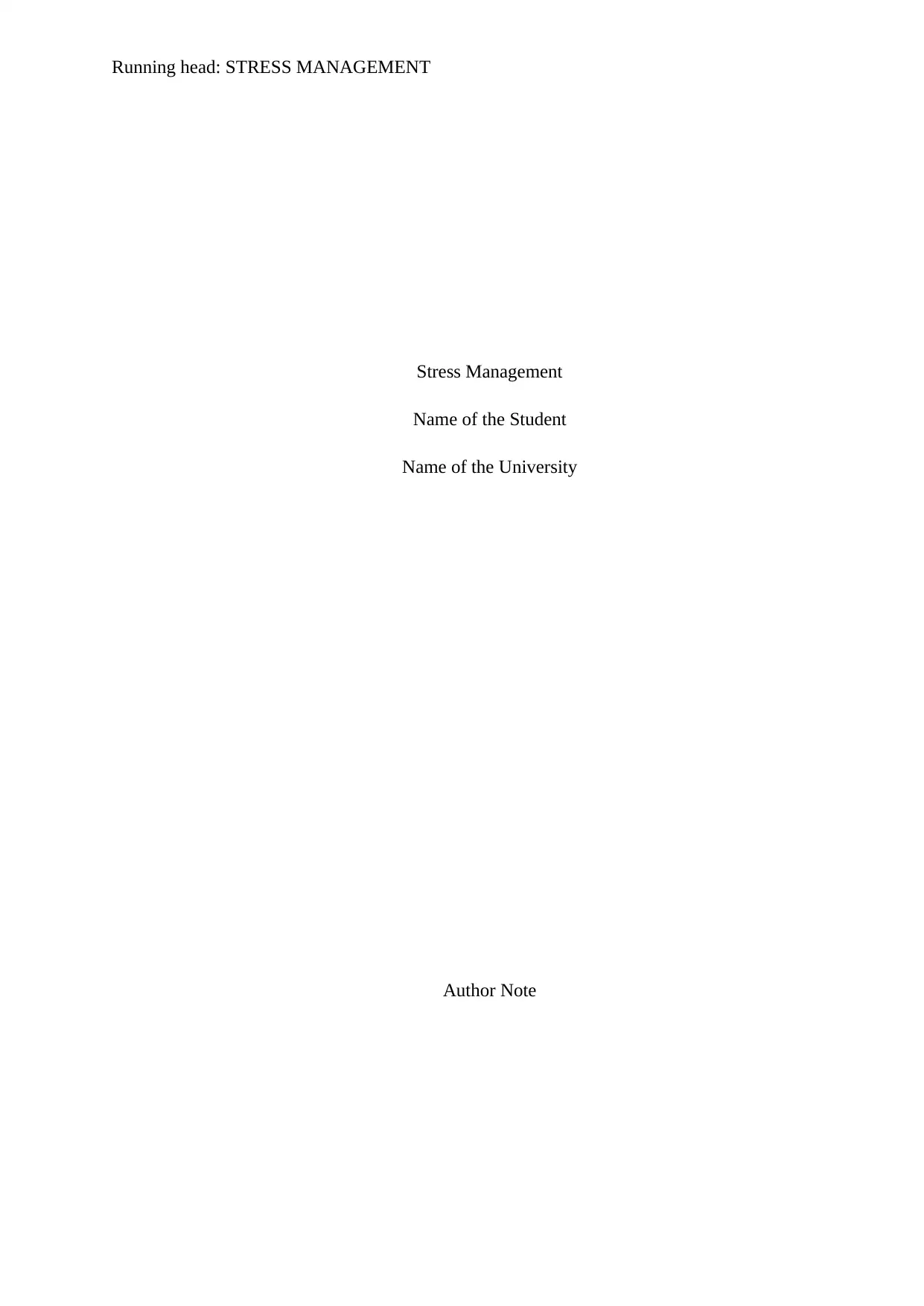
Running head: STRESS MANAGEMENT
Stress Management
Name of the Student
Name of the University
Author Note
Stress Management
Name of the Student
Name of the University
Author Note
Paraphrase This Document
Need a fresh take? Get an instant paraphrase of this document with our AI Paraphraser
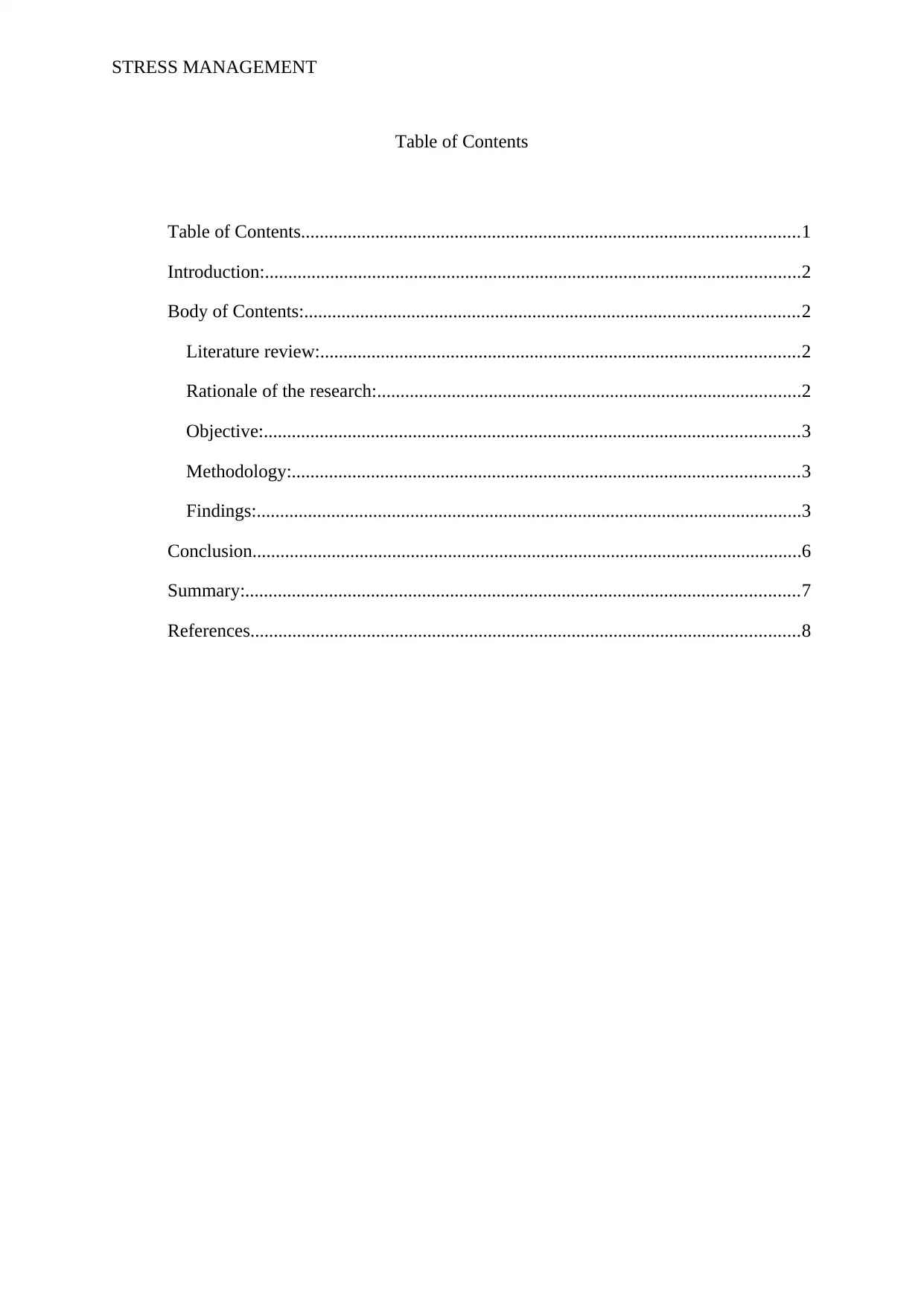
STRESS MANAGEMENT
Table of Contents
Table of Contents...........................................................................................................1
Introduction:...................................................................................................................2
Body of Contents:..........................................................................................................2
Literature review:.......................................................................................................2
Rationale of the research:...........................................................................................2
Objective:...................................................................................................................3
Methodology:.............................................................................................................3
Findings:.....................................................................................................................3
Conclusion......................................................................................................................6
Summary:.......................................................................................................................7
References......................................................................................................................8
Table of Contents
Table of Contents...........................................................................................................1
Introduction:...................................................................................................................2
Body of Contents:..........................................................................................................2
Literature review:.......................................................................................................2
Rationale of the research:...........................................................................................2
Objective:...................................................................................................................3
Methodology:.............................................................................................................3
Findings:.....................................................................................................................3
Conclusion......................................................................................................................6
Summary:.......................................................................................................................7
References......................................................................................................................8
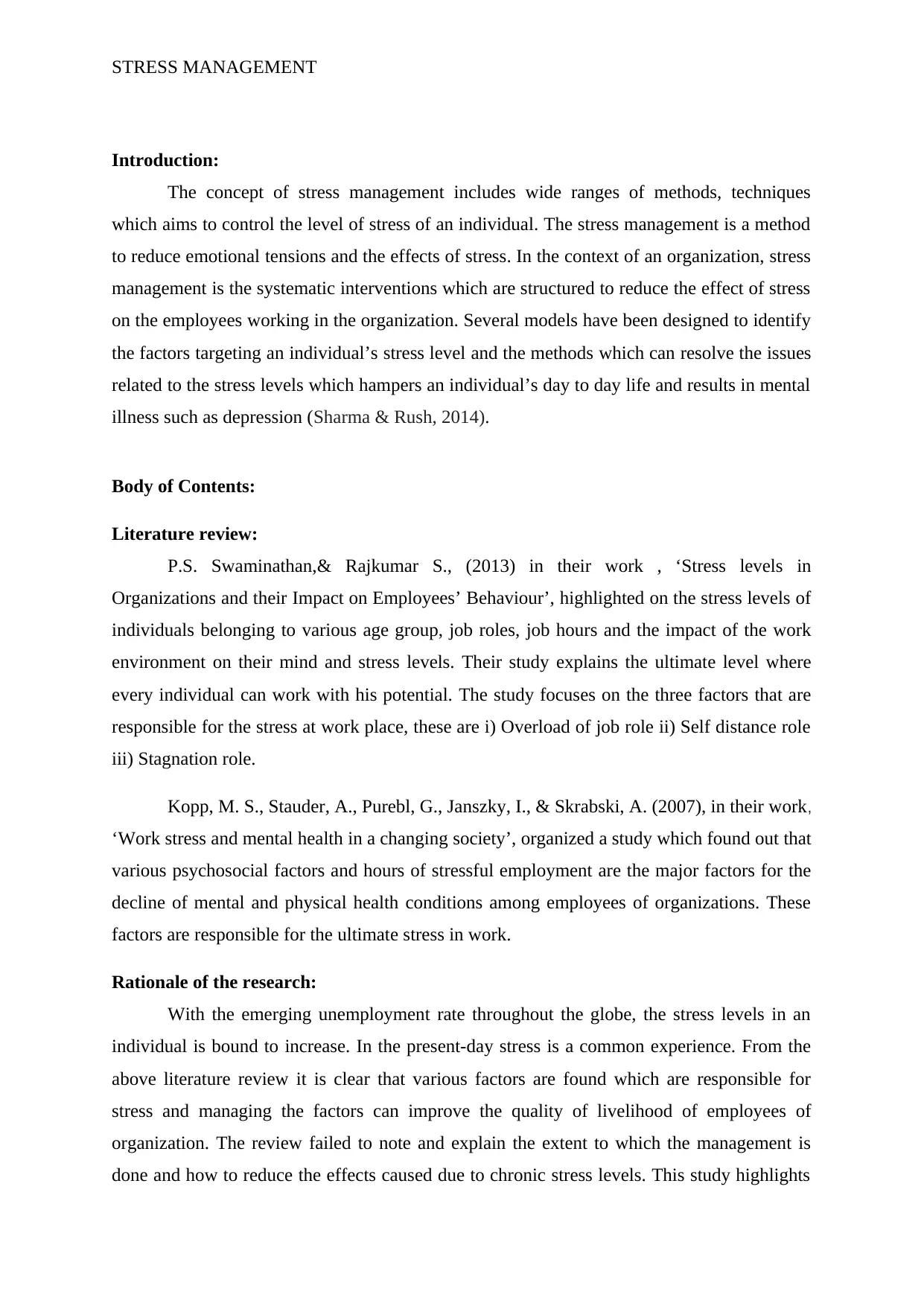
STRESS MANAGEMENT
Introduction:
The concept of stress management includes wide ranges of methods, techniques
which aims to control the level of stress of an individual. The stress management is a method
to reduce emotional tensions and the effects of stress. In the context of an organization, stress
management is the systematic interventions which are structured to reduce the effect of stress
on the employees working in the organization. Several models have been designed to identify
the factors targeting an individual’s stress level and the methods which can resolve the issues
related to the stress levels which hampers an individual’s day to day life and results in mental
illness such as depression (Sharma & Rush, 2014).
Body of Contents:
Literature review:
P.S. Swaminathan,& Rajkumar S., (2013) in their work , ‘Stress levels in
Organizations and their Impact on Employees’ Behaviour’, highlighted on the stress levels of
individuals belonging to various age group, job roles, job hours and the impact of the work
environment on their mind and stress levels. Their study explains the ultimate level where
every individual can work with his potential. The study focuses on the three factors that are
responsible for the stress at work place, these are i) Overload of job role ii) Self distance role
iii) Stagnation role.
Kopp, M. S., Stauder, A., Purebl, G., Janszky, I., & Skrabski, A. (2007), in their work,
‘Work stress and mental health in a changing society’, organized a study which found out that
various psychosocial factors and hours of stressful employment are the major factors for the
decline of mental and physical health conditions among employees of organizations. These
factors are responsible for the ultimate stress in work.
Rationale of the research:
With the emerging unemployment rate throughout the globe, the stress levels in an
individual is bound to increase. In the present-day stress is a common experience. From the
above literature review it is clear that various factors are found which are responsible for
stress and managing the factors can improve the quality of livelihood of employees of
organization. The review failed to note and explain the extent to which the management is
done and how to reduce the effects caused due to chronic stress levels. This study highlights
Introduction:
The concept of stress management includes wide ranges of methods, techniques
which aims to control the level of stress of an individual. The stress management is a method
to reduce emotional tensions and the effects of stress. In the context of an organization, stress
management is the systematic interventions which are structured to reduce the effect of stress
on the employees working in the organization. Several models have been designed to identify
the factors targeting an individual’s stress level and the methods which can resolve the issues
related to the stress levels which hampers an individual’s day to day life and results in mental
illness such as depression (Sharma & Rush, 2014).
Body of Contents:
Literature review:
P.S. Swaminathan,& Rajkumar S., (2013) in their work , ‘Stress levels in
Organizations and their Impact on Employees’ Behaviour’, highlighted on the stress levels of
individuals belonging to various age group, job roles, job hours and the impact of the work
environment on their mind and stress levels. Their study explains the ultimate level where
every individual can work with his potential. The study focuses on the three factors that are
responsible for the stress at work place, these are i) Overload of job role ii) Self distance role
iii) Stagnation role.
Kopp, M. S., Stauder, A., Purebl, G., Janszky, I., & Skrabski, A. (2007), in their work,
‘Work stress and mental health in a changing society’, organized a study which found out that
various psychosocial factors and hours of stressful employment are the major factors for the
decline of mental and physical health conditions among employees of organizations. These
factors are responsible for the ultimate stress in work.
Rationale of the research:
With the emerging unemployment rate throughout the globe, the stress levels in an
individual is bound to increase. In the present-day stress is a common experience. From the
above literature review it is clear that various factors are found which are responsible for
stress and managing the factors can improve the quality of livelihood of employees of
organization. The review failed to note and explain the extent to which the management is
done and how to reduce the effects caused due to chronic stress levels. This study highlights
⊘ This is a preview!⊘
Do you want full access?
Subscribe today to unlock all pages.

Trusted by 1+ million students worldwide
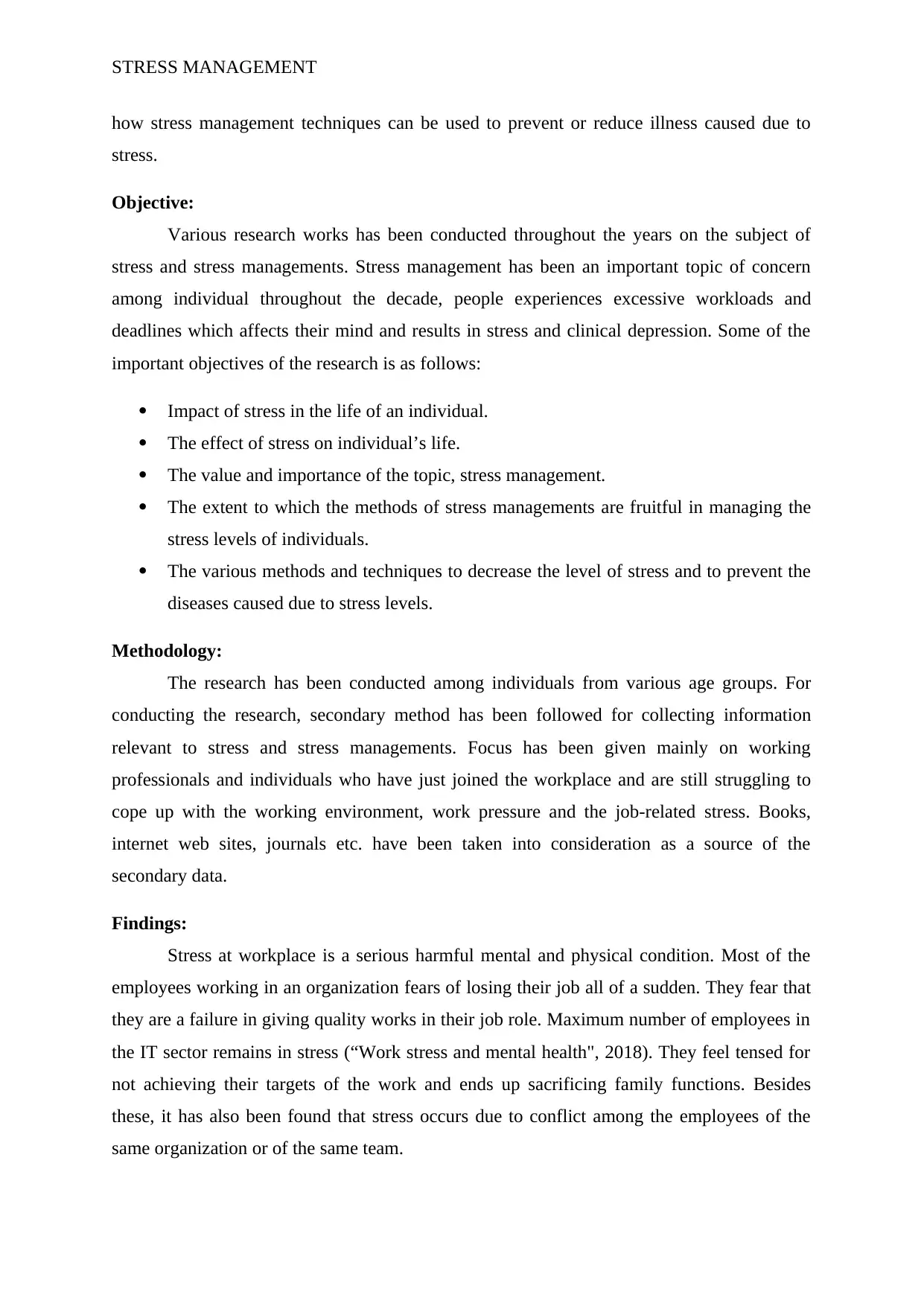
STRESS MANAGEMENT
how stress management techniques can be used to prevent or reduce illness caused due to
stress.
Objective:
Various research works has been conducted throughout the years on the subject of
stress and stress managements. Stress management has been an important topic of concern
among individual throughout the decade, people experiences excessive workloads and
deadlines which affects their mind and results in stress and clinical depression. Some of the
important objectives of the research is as follows:
Impact of stress in the life of an individual.
The effect of stress on individual’s life.
The value and importance of the topic, stress management.
The extent to which the methods of stress managements are fruitful in managing the
stress levels of individuals.
The various methods and techniques to decrease the level of stress and to prevent the
diseases caused due to stress levels.
Methodology:
The research has been conducted among individuals from various age groups. For
conducting the research, secondary method has been followed for collecting information
relevant to stress and stress managements. Focus has been given mainly on working
professionals and individuals who have just joined the workplace and are still struggling to
cope up with the working environment, work pressure and the job-related stress. Books,
internet web sites, journals etc. have been taken into consideration as a source of the
secondary data.
Findings:
Stress at workplace is a serious harmful mental and physical condition. Most of the
employees working in an organization fears of losing their job all of a sudden. They fear that
they are a failure in giving quality works in their job role. Maximum number of employees in
the IT sector remains in stress (“Work stress and mental health", 2018). They feel tensed for
not achieving their targets of the work and ends up sacrificing family functions. Besides
these, it has also been found that stress occurs due to conflict among the employees of the
same organization or of the same team.
how stress management techniques can be used to prevent or reduce illness caused due to
stress.
Objective:
Various research works has been conducted throughout the years on the subject of
stress and stress managements. Stress management has been an important topic of concern
among individual throughout the decade, people experiences excessive workloads and
deadlines which affects their mind and results in stress and clinical depression. Some of the
important objectives of the research is as follows:
Impact of stress in the life of an individual.
The effect of stress on individual’s life.
The value and importance of the topic, stress management.
The extent to which the methods of stress managements are fruitful in managing the
stress levels of individuals.
The various methods and techniques to decrease the level of stress and to prevent the
diseases caused due to stress levels.
Methodology:
The research has been conducted among individuals from various age groups. For
conducting the research, secondary method has been followed for collecting information
relevant to stress and stress managements. Focus has been given mainly on working
professionals and individuals who have just joined the workplace and are still struggling to
cope up with the working environment, work pressure and the job-related stress. Books,
internet web sites, journals etc. have been taken into consideration as a source of the
secondary data.
Findings:
Stress at workplace is a serious harmful mental and physical condition. Most of the
employees working in an organization fears of losing their job all of a sudden. They fear that
they are a failure in giving quality works in their job role. Maximum number of employees in
the IT sector remains in stress (“Work stress and mental health", 2018). They feel tensed for
not achieving their targets of the work and ends up sacrificing family functions. Besides
these, it has also been found that stress occurs due to conflict among the employees of the
same organization or of the same team.
Paraphrase This Document
Need a fresh take? Get an instant paraphrase of this document with our AI Paraphraser
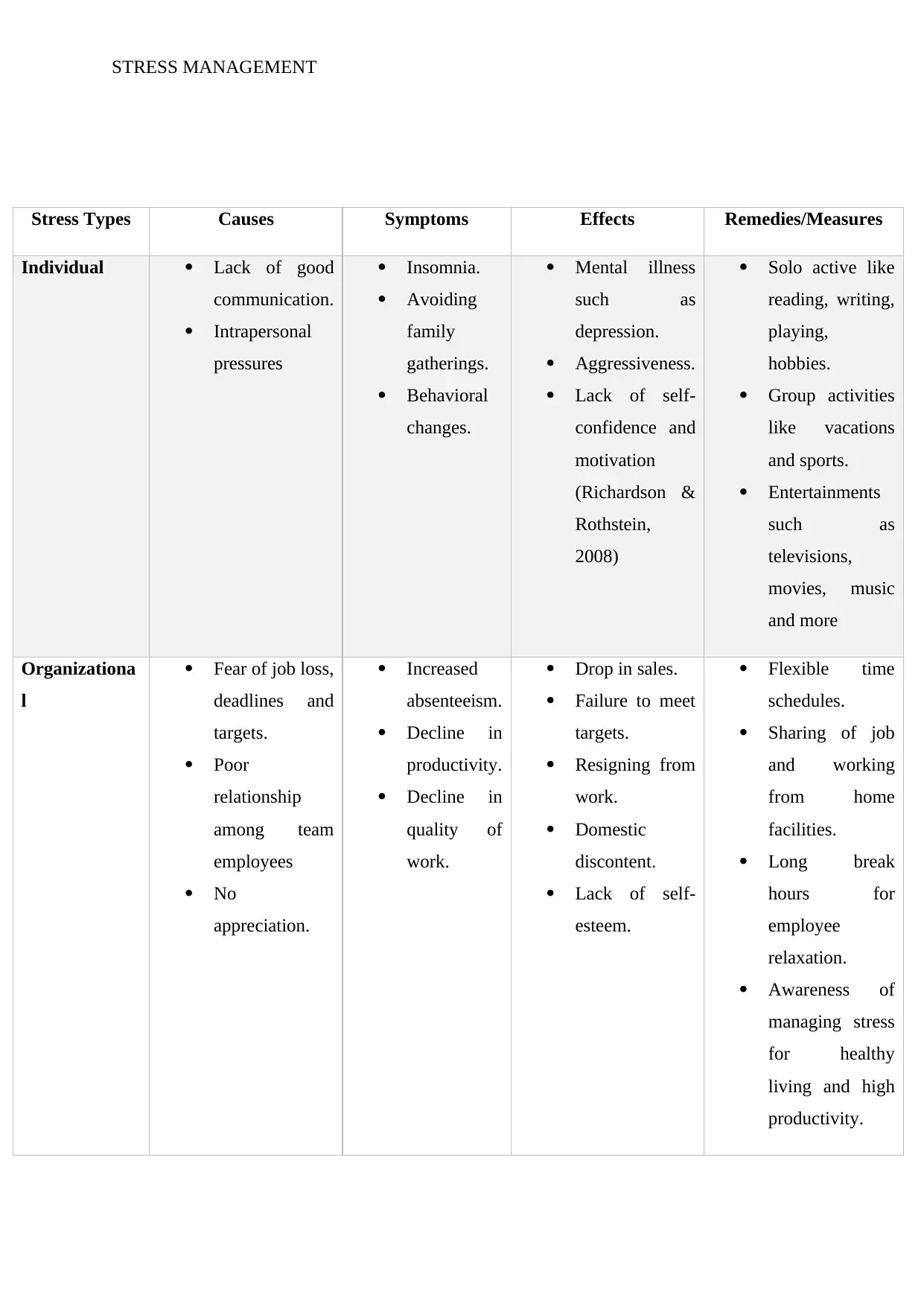
STRESS MANAGEMENT
Stress Types Causes Symptoms Effects Remedies/Measures
Individual Lack of good
communication.
Intrapersonal
pressures
Insomnia.
Avoiding
family
gatherings.
Behavioral
changes.
Mental illness
such as
depression.
Aggressiveness.
Lack of self-
confidence and
motivation
(Richardson &
Rothstein,
2008)
Solo active like
reading, writing,
playing,
hobbies.
Group activities
like vacations
and sports.
Entertainments
such as
televisions,
movies, music
and more
Organizationa
l
Fear of job loss,
deadlines and
targets.
Poor
relationship
among team
employees
No
appreciation.
Increased
absenteeism.
Decline in
productivity.
Decline in
quality of
work.
Drop in sales.
Failure to meet
targets.
Resigning from
work.
Domestic
discontent.
Lack of self-
esteem.
Flexible time
schedules.
Sharing of job
and working
from home
facilities.
Long break
hours for
employee
relaxation.
Awareness of
managing stress
for healthy
living and high
productivity.
Stress Types Causes Symptoms Effects Remedies/Measures
Individual Lack of good
communication.
Intrapersonal
pressures
Insomnia.
Avoiding
family
gatherings.
Behavioral
changes.
Mental illness
such as
depression.
Aggressiveness.
Lack of self-
confidence and
motivation
(Richardson &
Rothstein,
2008)
Solo active like
reading, writing,
playing,
hobbies.
Group activities
like vacations
and sports.
Entertainments
such as
televisions,
movies, music
and more
Organizationa
l
Fear of job loss,
deadlines and
targets.
Poor
relationship
among team
employees
No
appreciation.
Increased
absenteeism.
Decline in
productivity.
Decline in
quality of
work.
Drop in sales.
Failure to meet
targets.
Resigning from
work.
Domestic
discontent.
Lack of self-
esteem.
Flexible time
schedules.
Sharing of job
and working
from home
facilities.
Long break
hours for
employee
relaxation.
Awareness of
managing stress
for healthy
living and high
productivity.
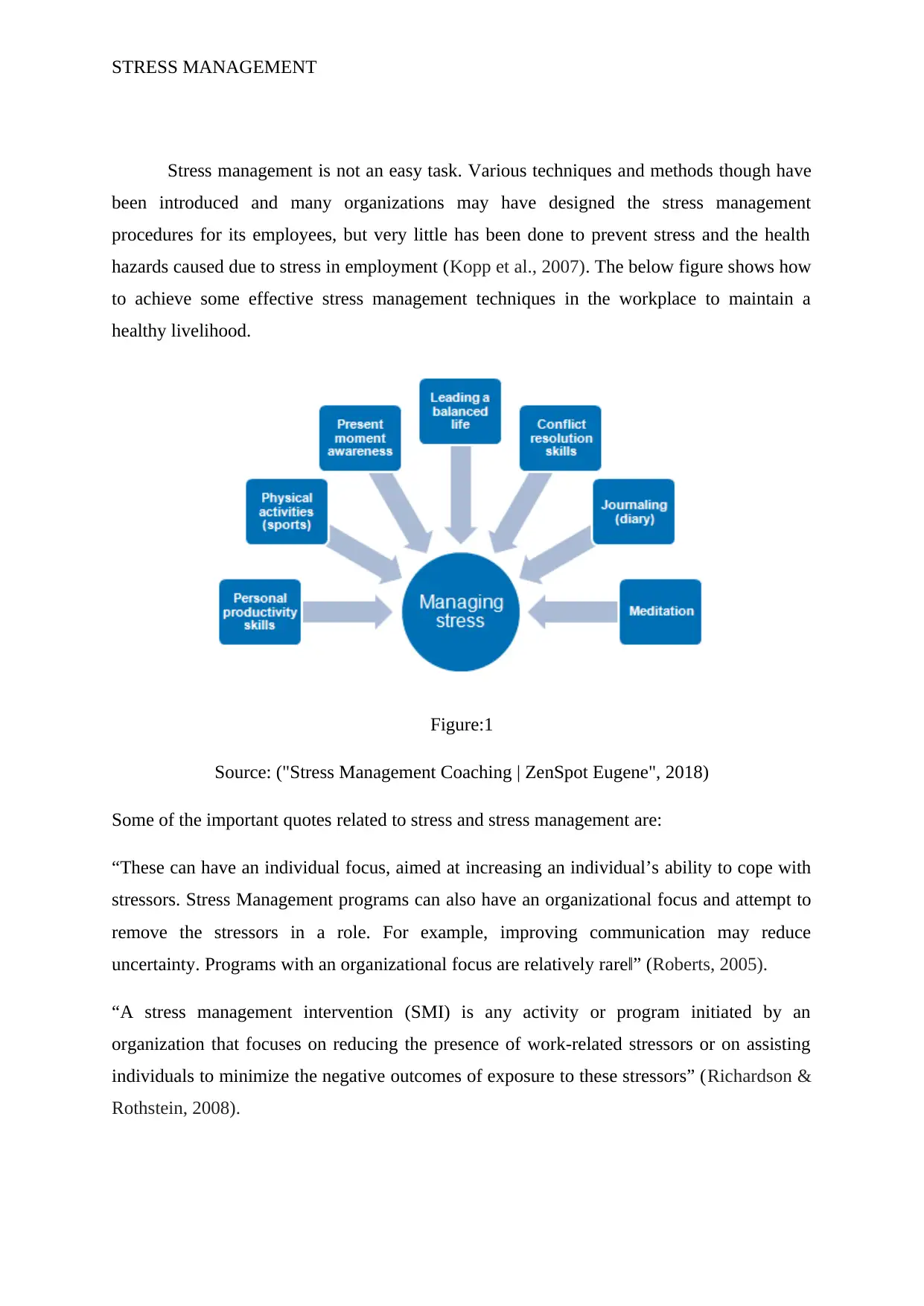
STRESS MANAGEMENT
Stress management is not an easy task. Various techniques and methods though have
been introduced and many organizations may have designed the stress management
procedures for its employees, but very little has been done to prevent stress and the health
hazards caused due to stress in employment (Kopp et al., 2007). The below figure shows how
to achieve some effective stress management techniques in the workplace to maintain a
healthy livelihood.
Figure:1
Source: ("Stress Management Coaching | ZenSpot Eugene", 2018)
Some of the important quotes related to stress and stress management are:
“These can have an individual focus, aimed at increasing an individual’s ability to cope with
stressors. Stress Management programs can also have an organizational focus and attempt to
remove the stressors in a role. For example, improving communication may reduce
uncertainty. Programs with an organizational focus are relatively rare‖” (Roberts, 2005).
“A stress management intervention (SMI) is any activity or program initiated by an
organization that focuses on reducing the presence of work-related stressors or on assisting
individuals to minimize the negative outcomes of exposure to these stressors” (Richardson &
Rothstein, 2008).
Stress management is not an easy task. Various techniques and methods though have
been introduced and many organizations may have designed the stress management
procedures for its employees, but very little has been done to prevent stress and the health
hazards caused due to stress in employment (Kopp et al., 2007). The below figure shows how
to achieve some effective stress management techniques in the workplace to maintain a
healthy livelihood.
Figure:1
Source: ("Stress Management Coaching | ZenSpot Eugene", 2018)
Some of the important quotes related to stress and stress management are:
“These can have an individual focus, aimed at increasing an individual’s ability to cope with
stressors. Stress Management programs can also have an organizational focus and attempt to
remove the stressors in a role. For example, improving communication may reduce
uncertainty. Programs with an organizational focus are relatively rare‖” (Roberts, 2005).
“A stress management intervention (SMI) is any activity or program initiated by an
organization that focuses on reducing the presence of work-related stressors or on assisting
individuals to minimize the negative outcomes of exposure to these stressors” (Richardson &
Rothstein, 2008).
⊘ This is a preview!⊘
Do you want full access?
Subscribe today to unlock all pages.

Trusted by 1+ million students worldwide
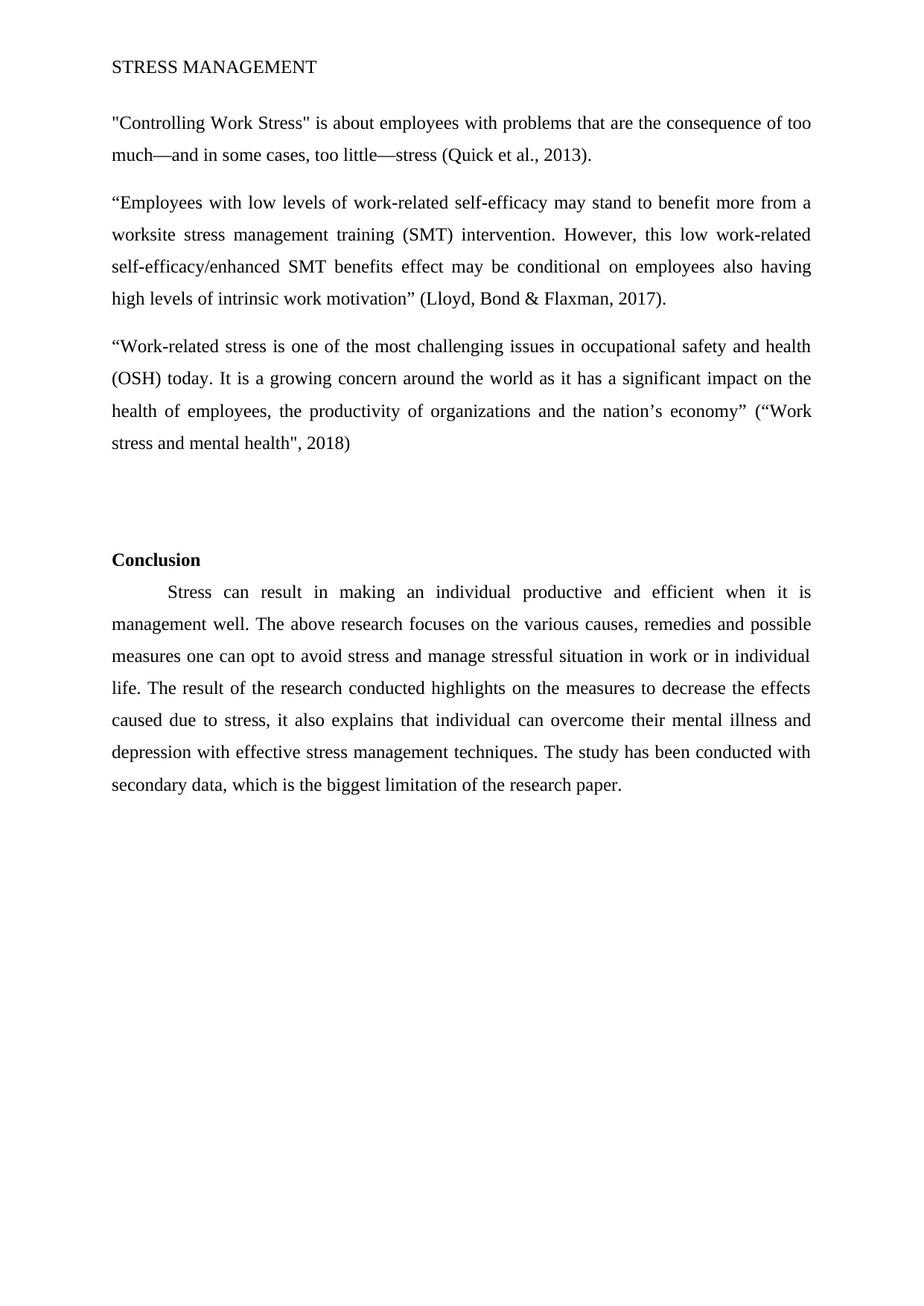
STRESS MANAGEMENT
"Controlling Work Stress" is about employees with problems that are the consequence of too
much—and in some cases, too little—stress (Quick et al., 2013).
“Employees with low levels of work-related self-efficacy may stand to benefit more from a
worksite stress management training (SMT) intervention. However, this low work-related
self-efficacy/enhanced SMT benefits effect may be conditional on employees also having
high levels of intrinsic work motivation” (Lloyd, Bond & Flaxman, 2017).
“Work-related stress is one of the most challenging issues in occupational safety and health
(OSH) today. It is a growing concern around the world as it has a significant impact on the
health of employees, the productivity of organizations and the nation’s economy” (“Work
stress and mental health", 2018)
Conclusion
Stress can result in making an individual productive and efficient when it is
management well. The above research focuses on the various causes, remedies and possible
measures one can opt to avoid stress and manage stressful situation in work or in individual
life. The result of the research conducted highlights on the measures to decrease the effects
caused due to stress, it also explains that individual can overcome their mental illness and
depression with effective stress management techniques. The study has been conducted with
secondary data, which is the biggest limitation of the research paper.
"Controlling Work Stress" is about employees with problems that are the consequence of too
much—and in some cases, too little—stress (Quick et al., 2013).
“Employees with low levels of work-related self-efficacy may stand to benefit more from a
worksite stress management training (SMT) intervention. However, this low work-related
self-efficacy/enhanced SMT benefits effect may be conditional on employees also having
high levels of intrinsic work motivation” (Lloyd, Bond & Flaxman, 2017).
“Work-related stress is one of the most challenging issues in occupational safety and health
(OSH) today. It is a growing concern around the world as it has a significant impact on the
health of employees, the productivity of organizations and the nation’s economy” (“Work
stress and mental health", 2018)
Conclusion
Stress can result in making an individual productive and efficient when it is
management well. The above research focuses on the various causes, remedies and possible
measures one can opt to avoid stress and manage stressful situation in work or in individual
life. The result of the research conducted highlights on the measures to decrease the effects
caused due to stress, it also explains that individual can overcome their mental illness and
depression with effective stress management techniques. The study has been conducted with
secondary data, which is the biggest limitation of the research paper.
Paraphrase This Document
Need a fresh take? Get an instant paraphrase of this document with our AI Paraphraser
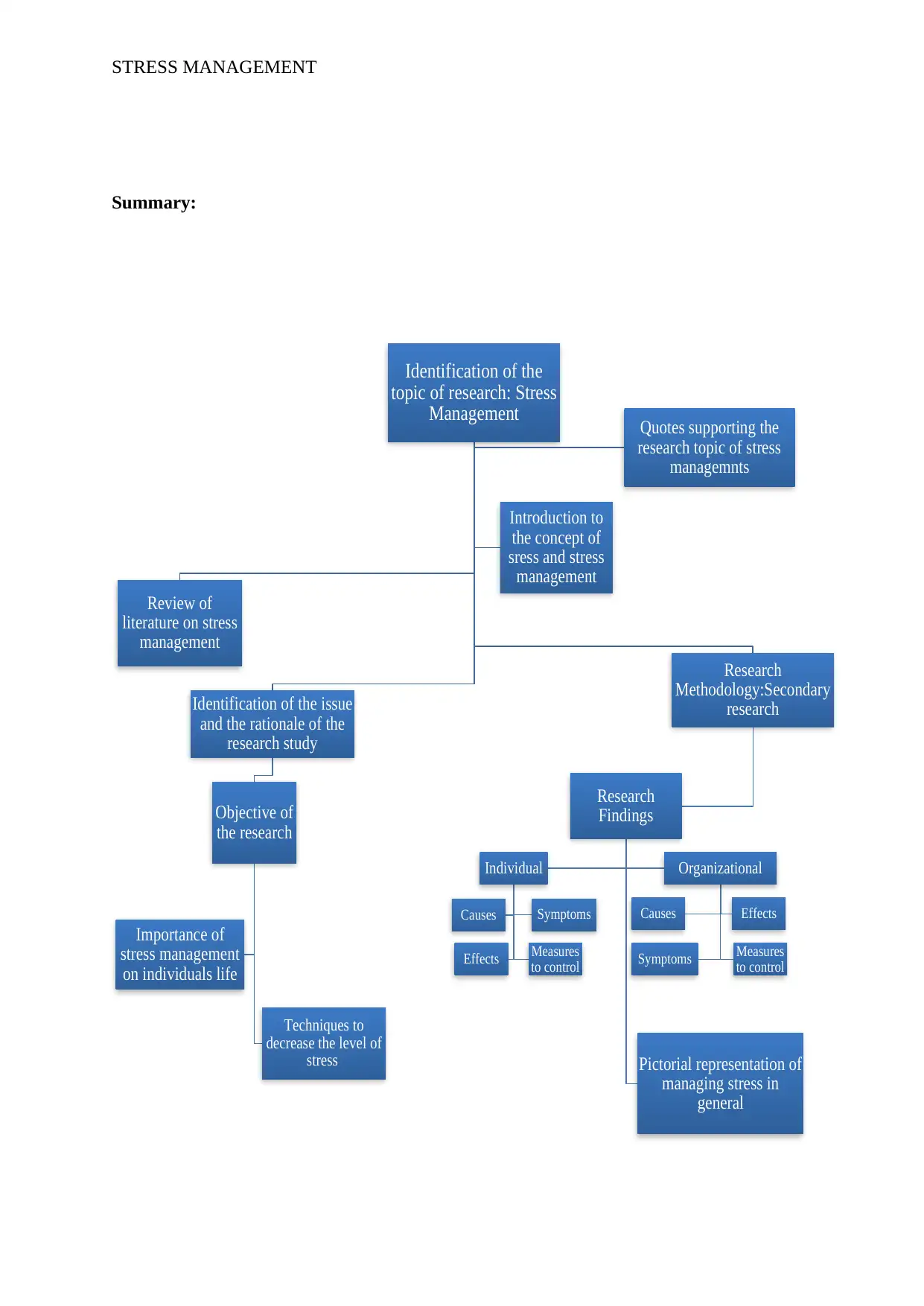
STRESS MANAGEMENT
Summary:
Identification of the
topic of research: Stress
Management
Review of
literature on stress
management
Identification of the issue
and the rationale of the
research study
Objective of
the research
Importance of
stress management
on individuals life
Techniques to
decrease the level of
stress
Research
Methodology:Secondary
research
Research
Findings
Individual
Causes Symptoms
Effects Measures
to control
Organizational
Causes Effects
Symptoms Measures
to control
Pictorial representation of
managing stress in
general
Introduction to
the concept of
sress and stress
management
Quotes supporting the
research topic of stress
managemnts
Summary:
Identification of the
topic of research: Stress
Management
Review of
literature on stress
management
Identification of the issue
and the rationale of the
research study
Objective of
the research
Importance of
stress management
on individuals life
Techniques to
decrease the level of
stress
Research
Methodology:Secondary
research
Research
Findings
Individual
Causes Symptoms
Effects Measures
to control
Organizational
Causes Effects
Symptoms Measures
to control
Pictorial representation of
managing stress in
general
Introduction to
the concept of
sress and stress
management
Quotes supporting the
research topic of stress
managemnts
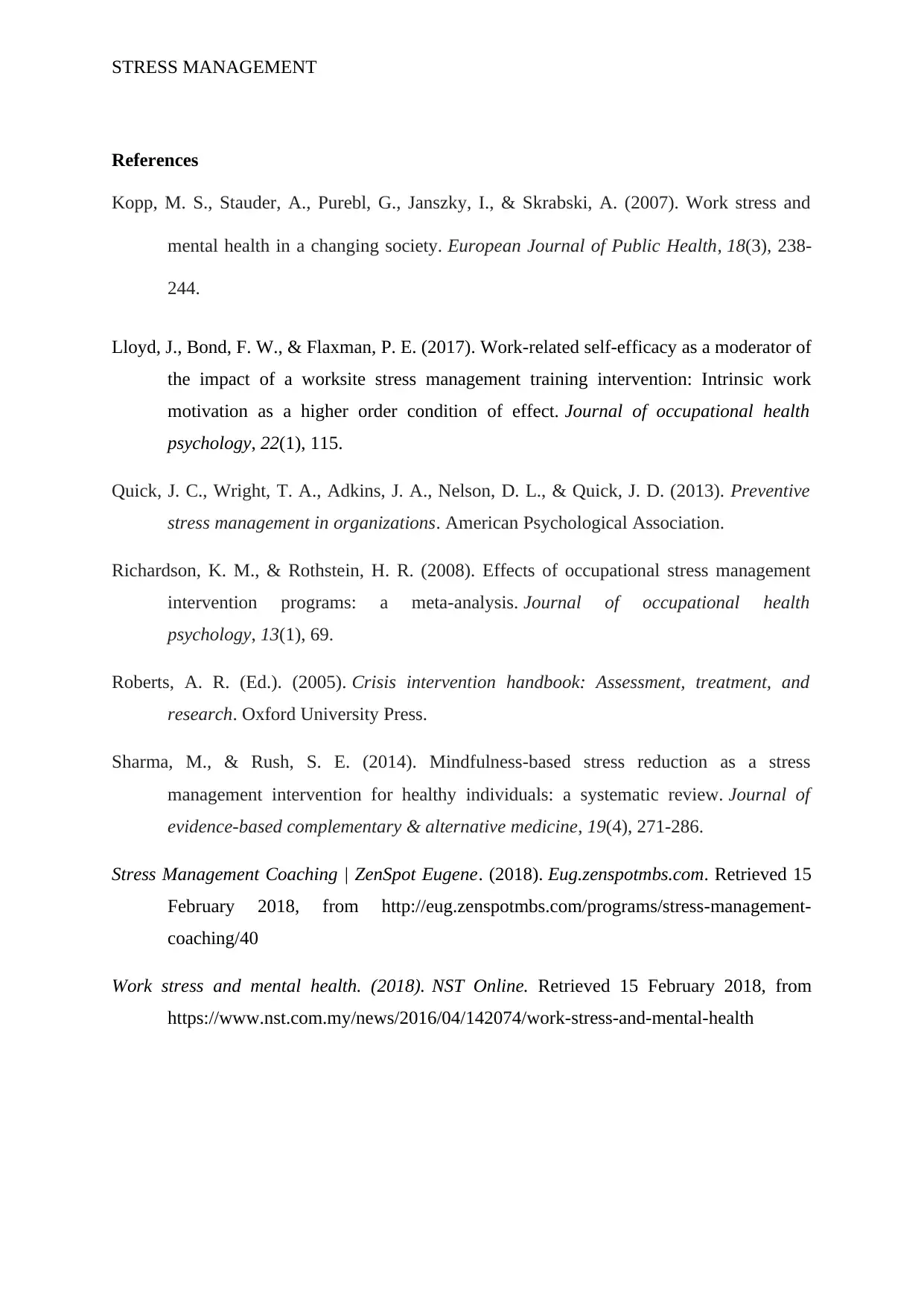
STRESS MANAGEMENT
References
Kopp, M. S., Stauder, A., Purebl, G., Janszky, I., & Skrabski, A. (2007). Work stress and
mental health in a changing society. European Journal of Public Health, 18(3), 238-
244.
Lloyd, J., Bond, F. W., & Flaxman, P. E. (2017). Work-related self-efficacy as a moderator of
the impact of a worksite stress management training intervention: Intrinsic work
motivation as a higher order condition of effect. Journal of occupational health
psychology, 22(1), 115.
Quick, J. C., Wright, T. A., Adkins, J. A., Nelson, D. L., & Quick, J. D. (2013). Preventive
stress management in organizations. American Psychological Association.
Richardson, K. M., & Rothstein, H. R. (2008). Effects of occupational stress management
intervention programs: a meta-analysis. Journal of occupational health
psychology, 13(1), 69.
Roberts, A. R. (Ed.). (2005). Crisis intervention handbook: Assessment, treatment, and
research. Oxford University Press.
Sharma, M., & Rush, S. E. (2014). Mindfulness-based stress reduction as a stress
management intervention for healthy individuals: a systematic review. Journal of
evidence-based complementary & alternative medicine, 19(4), 271-286.
Stress Management Coaching | ZenSpot Eugene. (2018). Eug.zenspotmbs.com. Retrieved 15
February 2018, from http://eug.zenspotmbs.com/programs/stress-management-
coaching/40
Work stress and mental health. (2018). NST Online. Retrieved 15 February 2018, from
https://www.nst.com.my/news/2016/04/142074/work-stress-and-mental-health
References
Kopp, M. S., Stauder, A., Purebl, G., Janszky, I., & Skrabski, A. (2007). Work stress and
mental health in a changing society. European Journal of Public Health, 18(3), 238-
244.
Lloyd, J., Bond, F. W., & Flaxman, P. E. (2017). Work-related self-efficacy as a moderator of
the impact of a worksite stress management training intervention: Intrinsic work
motivation as a higher order condition of effect. Journal of occupational health
psychology, 22(1), 115.
Quick, J. C., Wright, T. A., Adkins, J. A., Nelson, D. L., & Quick, J. D. (2013). Preventive
stress management in organizations. American Psychological Association.
Richardson, K. M., & Rothstein, H. R. (2008). Effects of occupational stress management
intervention programs: a meta-analysis. Journal of occupational health
psychology, 13(1), 69.
Roberts, A. R. (Ed.). (2005). Crisis intervention handbook: Assessment, treatment, and
research. Oxford University Press.
Sharma, M., & Rush, S. E. (2014). Mindfulness-based stress reduction as a stress
management intervention for healthy individuals: a systematic review. Journal of
evidence-based complementary & alternative medicine, 19(4), 271-286.
Stress Management Coaching | ZenSpot Eugene. (2018). Eug.zenspotmbs.com. Retrieved 15
February 2018, from http://eug.zenspotmbs.com/programs/stress-management-
coaching/40
Work stress and mental health. (2018). NST Online. Retrieved 15 February 2018, from
https://www.nst.com.my/news/2016/04/142074/work-stress-and-mental-health
⊘ This is a preview!⊘
Do you want full access?
Subscribe today to unlock all pages.

Trusted by 1+ million students worldwide
1 out of 9
Related Documents
Your All-in-One AI-Powered Toolkit for Academic Success.
+13062052269
info@desklib.com
Available 24*7 on WhatsApp / Email
![[object Object]](/_next/static/media/star-bottom.7253800d.svg)
Unlock your academic potential
Copyright © 2020–2025 A2Z Services. All Rights Reserved. Developed and managed by ZUCOL.





